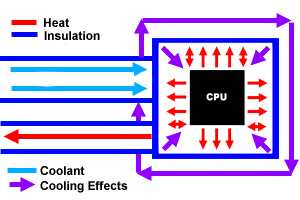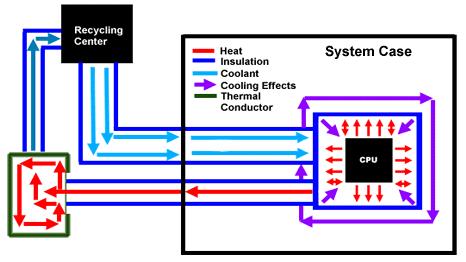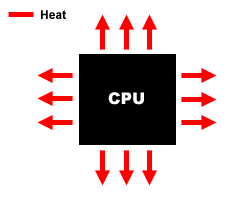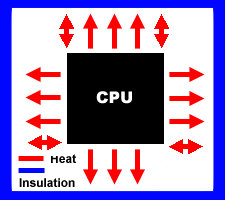
Original Link: https://www.anandtech.com/show/164
Alternative Cooling at its Best
by Anand Lal Shimpi on October 24, 1998 2:46 PM EST- Posted in
- Cases/Cooling/PSUs
I remember flipping through an old computing magazine to find a monstrous case on the front cover with a headline depicting the world's first 25MHz 386 months before Intel ever released the processor at 25MHz. At the heart of this $10,000 "super system" was an Intel 386-20 running at 25MHz, how did the manufacturer manage to accomplish this for a "mere" ten grand? By doing something we all take for granted in the current day of computing. Getting something for nothing, the free upgrade, no, not the "four finger discount" rather what we have all come to know as overclocking.
A 5MHz overclock is hardly anything by today's standards, what was once thought to be an amazing accomplishment when you overclocked your 5x86-133 to 150MHz is now the bare minimum for overclocking. Users running their 300MHz Celeron processors at 450MHz will be the first to tell you that we've definitely come a long way from the days when a 386 running at 25MHz could win the front cover of a computing magazine. At the same time, we're reaching the limits of what a well manufactured processor and a $30 heatsink/fan can offer us. With the first barrier keeping us from overclocking the current generation of processors beyond the limits we've already pushed them to obviously being heat, the question has been posed time and time again, and now we'll take the first steps towards a simple answer...get ready to beat the heat as AnandTech takes a look at alternative cooling methods at their best.
If you can't stand the heat...freeze the kitchen
Here's the problem: We have a ceramic plate no larger than 2.5" x 2.5", running at 100 degrees Fahrenheit under normal conditions, and running at 120+ degrees overclocked...and we need to cool it down to more than half that temperature. This is the point at which air fails us, and where the creative mind must be allowed to roam free, it is this point at which a company started by a group of 5 people with a common vision attempted to solve the problems of the overclocking world with their cooling technology. The company, rightfully dubbed, Kryotech, developed a vapor phase refrigeration technique that can effectively cool a CMOS device (such as the processor in your system) down to -40 degrees Celsius, a fairly standard refrigeration temperature.
Much like placing your CPU in a freezer, the Kryotech design resembles that of your home refrigerator in terms of performance, and proportionally, in terms of size. The Kryotech design must be implemented in its own specially constructed case and shipped pre-configured in terms of processor choice. While this design (you can read more about the Kryotech design in particular at www.kryotech.com) offers numerous benefits, the release of a practical version of the design or even a remotely available version of Kryotech's most highly anticipated product, the CoolK6 (a K6-2 333 overclocked to 450MHz), have kept Kryotech from rising to their rightfully deserved position among overclockers. At the same time, the $1600 price tag of a Kryotech CoolK6 System (price includes case, cooling system, motherboard, and CPU) isn't too practical for even most high end users as a Pentium II 450 can be picked up for much less and offer similar performance.
But if Kryotech can do it...why can't anyone else? In preparation for an ongoing AnandTech special on alternative cooling, let's start off by outlining exactly what we need to have a successful cooling device, not only for processors, but for video chipsets and other such peripherals as well.
Defining the Goal
| The key to a successful cooling system is realizing your goal. For the purpose of overclocking, defining a "successful cooling system" depends directly upon the success of your overclocking experiment. This article will concentrate on an average overclock for this sort of cooling, nothing like the 333MHz to 450MHz overclock which Kryotech accomplished, rather something more in the middle. With your processor constantly producing heat, the problem or goal is to remove as much of that heat as quickly as possible therefore keeping your processor free to produce even more heat without any adverse effects on the stability of your system. While that seems relatively simple, it requires a perfect understanding in order to pursue the construction of the rest of the cooling system. |
|
Isolating the Problem
| In order to properly cool any single device, one must isolate it from all other sources of heat in its surroundings. This means, enclosing the CPU in some sort of a capsule. The stipulations for this capsule dictate that it must be a well insulated capsule, in that it should be a poor thermal conductor so we keep the heat inside of the capsule. Make an opening in the capsule and what do we get? An intake valve. By allowing a coolant to flow into the intake valve, in the most simple of terms this coolant could be water, it flows over the surface of the CPU therefore replacing the air in the capsule as a conductor of heat. By definition water is a much better conductor of heat and therefore works much more effectively at carrying the heat away from the processor than air itself. What do we do once the water has absorbed the heat from the processor? |
|
| Well, make another opening in the capsule and we've got ourselves a handy little outtake valve. By channeling the heated water through that opening, the heat is effectively removed from the processor and our goal accomplished. | |
The tubing being fed to the intake and outtake valves must be insulated as to keep the heat and the coolant as hot and cool as possible while inside the case of your system. You definitely don't want to lose any heat to other components in your system which would introduce new possibilities for instability, and if you want to overclock you sure don't want to lose any of your coolant to the air in the system case. We'll wait until we're out of the case to worry about getting rid of the heat. Possibilities for tubing material include plastic, vinyl, or other such materials as they provide generally decent insulation for the type of problems we'll be introducing.
What have we accomplished so far? We've defined our goal, established a way of introducing a coolant to the processor, removing heat, and channeling it away, however what do we do with that heat and how do we add closure to this system of ours? Keep on reading...
Do WHAT with the Heat Now?
It's quite doubtful that you want the heat from your processor warming your case, and unless you have cold summers you probably don't want it filling your room with a warm gust of air every time you turn on the computer to surf the net. At the same time, it would be impractical to have the cooler be anything but self sufficient, the solution? Recycle the heat.

Figure 4. Thermal Exchange with an Outtake Valve
In removing the heat from the processor we've managed to put ourselves in a bit of a predicament, how do we cool the cooling system? The heat in the thermal conductor medium, in the example case, water, being channeled down the outtake valve coming from the processor (once outside of the case as to prevent the heating of any other components) needs to eventually be fed back into the loop via either a pump or a compressor (depending on whether you're using liquid or vapor based cooling, the latter being much more difficult) to keep the cooling cycle going and make the system self-sufficient. If the need for self-sufficiency didn't exist then one could theoretically continuously pump cold water over the CPU allowing the excess water to run down into your drainage system. If this were a perfect world, then we could all do just that, unfortunately attaching the kitchen sink to your computer isn't the most cost effective thing to do. The solution? Cool the coolant on the way back to the recycling center of the system, if you're using the water approach, that will most likely be a pump of some sort. Here's where you want to abandon the plastic tubing and pursue a more efficient thermal conductor for the outtake valve. Depending on the power of your recycling center and the diameter of the tubing used for the intake valve, the type of material and size of tubing you use for the outtake tubing will vary. Aluminum or copper are the two biggest contenders for this job, in the end it comes down to which material you can find more readily available, we're not going to hold an Aluminum vs Copper discussion here, however you're welcome to discuss the two solutions (engineers are definitely welcome ;)...) on the AnandTech BBS.

Luckily, the job of cooling the coolant (as that's what you're actually doing) isn't as difficult as cooling the processor. Allowing the heat to dissipate on its own works fine as long as you're using a heatsink-like construction on top of the outtake tubing, otherwise you may want to consider alternative methods such as other forms of passive cooling (air works perfectly fine here). The key to overclocking using this type of a system is keeping the coolant, whether it is water, anti-freeze, or any other liquid as cool as possible. So let the creativity flow and experiment with this, as we're on the verge of toppling a great barrier and the more minds working on the solution the better.
A hurdle Kryotech managed to overcome by developing a patented technology to avoid it was that of the effects of condensation on the super-cooled CPU. By combining the heat generated by your processor and the cold temperatures introduced by the cooling system with the air openings between the pins of your processor we introduce a dangerous element into the system, condensation. The production and collection of water near any circuits, especially near the pins of a CPU is obviously not something you want happening. While we can't reproduce what Kryotech spent years developing, we can learn from their example.
Kryotech used a specially insulated socket which the CPU plugged into in order to eliminate condensation, by using a separate socket for the processor to plug into and then plugging that socket into the motherboard, Kryotech quickly solved the problem.
More experimentation needs to be performed in this area to determine the best type of insulation for a CPU's pins in order to prevent condensation. Some areas to ponder include using a decoupler between the processor and motherboard to imitate the design by Kryotech, while others include experimentation with substances with densities much greater than water while remaining insulators (non-conductors).
Paving the Road
This primer was mainly intended to get everyone thinking in terms of the problem and approaching the solution. Over the upcoming weeks and months, AnandTech will continue experimentation in the area of alternative cooling methods with periodical updates on progress in the development of a truly effective alternative cooling system. It's interesting to note how far a trip to a local hardware store and $100 can take you these days, much farther than a $10,000 super-system can take you, that's for sure ;)









